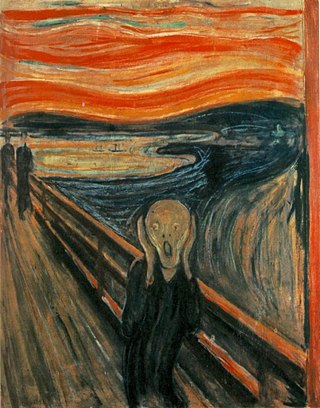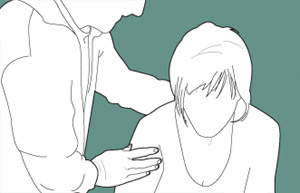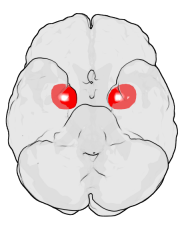Related Research Articles

Anxiety is an emotion which is characterised by an unpleasant state of inner turmoil and includes feelings of dread over anticipated events. Anxiety is different from fear in that fear is defined as the emotional response to a real threat, whereas anxiety is the anticipation of a future threat. It is often accompanied by nervous behavior such as pacing back and forth, somatic complaints, and rumination.

Fear is an intensely unpleasant emotion in response to perceiving or recognizing a danger or threat. Fear causes psychological changes that may produce behavioral reactions such as mounting an aggressive response or fleeing the threat. Fear in human beings may occur in response to a certain stimulus occurring in the present, or in anticipation or expectation of a future threat perceived as a risk to oneself. The fear response arises from the perception of danger leading to confrontation with or escape from/avoiding the threat, which in extreme cases of fear can be a freeze response.

A phobia is an anxiety disorder, defined by a persistent and excessive fear of an object or situation. Phobias typically result in a rapid onset of fear and are usually present for more than six months. Those affected go to great lengths to avoid the situation or object, to a degree greater than the actual danger posed. If the object or situation cannot be avoided, they experience significant distress. Other symptoms can include fainting, which may occur in blood or injury phobia, and panic attacks, often found in agoraphobia and emetophobia. Around 75% of those with phobias have multiple phobias.

Anxiety disorders are a cluster of mental disorders characterized by significant and uncontrollable feelings of anxiety and fear such that a person's social, occupational, and personal functions are significantly impaired. Anxiety may cause physical and cognitive symptoms, such as restlessness, irritability, easy fatigue, difficulty concentrating, increased heart rate, chest pain, abdominal pain, and a variety of other symptoms that may vary based on the individual.

Agoraphobia is a mental and behavioral disorder, specifically an anxiety disorder characterized by symptoms of anxiety in situations where the person perceives their environment to be unsafe with no easy way to escape. These situations can include public transit, shopping centers, crowds and queues, or simply being outside their home on their own. Being in these situations may result in a panic attack. Those affected will go to great lengths to avoid these situations. In severe cases, people may become completely unable to leave their homes.

Panic attacks are sudden periods of intense fear and discomfort that may include palpitations, sweating, chest pain or chest discomfort, shortness of breath, trembling, dizziness, numbness, confusion, or a feeling of impending doom or of losing control. Typically, symptoms reach a peak within ten minutes of onset, and last for roughly 30 minutes, but the duration can vary from seconds to hours. Although they can be extremely frightening and distressing, panic attacks themselves are not physically dangerous.

The amygdala is a paired nuclear complex present in the cerebral hemispheres of vertebrates. It is considered part of the limbic system. In primates, it is located medially within the temporal lobes. It consists of many nuclei, each made up of further subnuclei. The subdivision most commonly made is into the basolateral, central, cortical, and medial nuclei together with the intercalated cell clusters. The amygdala has a primary role in the processing of memory, decision-making, and emotional responses. The amygdala was first identified and named by Karl Friedrich Burdach in 1822.

Claustrophobia is a fear of confined spaces. It is triggered by many situations or stimuli, including elevators, especially when crowded to capacity, windowless rooms, and hotel rooms with closed doors and sealed windows. Even bedrooms with a lock on the outside, small cars, and tight-necked clothing can induce a response in those with claustrophobia. It is typically classified as an anxiety disorder, which often results in panic attacks. The onset of claustrophobia has been attributed to many factors, including a reduction in the size of the amygdala, classical conditioning, or a genetic predisposition to fear small spaces.
Generalized anxiety disorder (GAD) is a mental and behavioral disorder, specifically an anxiety disorder characterized by excessive, uncontrollable and often irrational worry about events or activities. Worry often interferes with daily functioning, and individuals with GAD are often overly concerned about everyday matters such as health, finances, death, family, relationship concerns, or work difficulties. Symptoms may include excessive worry, restlessness, trouble sleeping, exhaustion, irritability, sweating, and trembling.
Affective neuroscience is the study of how the brain processes emotions. This field combines neuroscience with the psychological study of personality, emotion, and mood. The basis of emotions and what emotions are remains an issue of debate within the field of affective neuroscience.

Worry refers to the thoughts, images, emotions, and actions of a negative nature in a repetitive, uncontrollable manner that results from a proactive cognitive risk analysis made to avoid or solve anticipated potential threats and their potential consequences.
Social anxiety is the anxiety and fear specifically linked to being in social settings. Some categories of disorders associated with social anxiety include anxiety disorders, mood disorders, autism spectrum disorders, eating disorders, and substance use disorders. Individuals with higher levels of social anxiety often avert their gazes, show fewer facial expressions, and show difficulty with initiating and maintaining a conversation. Social anxiety commonly manifests itself in the teenage years and can be persistent throughout life; however, people who experience problems in their daily functioning for an extended period of time can develop social anxiety disorder. Trait social anxiety, the stable tendency to experience this anxiety, can be distinguished from state anxiety, the momentary response to a particular social stimulus. Half of the individuals with any social fears meet the criteria for social anxiety disorder. Age, culture, and gender impact the severity of this disorder. The function of social anxiety is to increase arousal and attention to social interactions, inhibit unwanted social behavior, and motivate preparation for future social situations.
Memory and trauma is the deleterious effects that physical or psychological trauma has on memory.

Social anxiety disorder (SAD), also known as social phobia, is an anxiety disorder characterized by sentiments of fear and anxiety in social situations, causing considerable distress and impairing ability to function in at least some aspects of daily life. These fears can be triggered by perceived or actual scrutiny from others. Individuals with social anxiety disorder fear negative evaluations from other people.

Panic disorder is a mental and behavioral disorder, specifically an anxiety disorder characterized by reoccurring unexpected panic attacks. Panic attacks are sudden periods of intense fear that may include palpitations, sweating, shaking, shortness of breath, numbness, or a feeling that something terrible is going to happen. The maximum degree of symptoms occurs within minutes. There may be ongoing worries about having further attacks and avoidance of places where attacks have occurred in the past.
The management of traumatic memories is important when treating mental health disorders such as post traumatic stress disorder. Traumatic memories can cause life problems even to individuals who do not meet the diagnostic criteria for a mental health disorder. They result from traumatic experiences, including natural disasters such as earthquakes and tsunamis; violent events such as kidnapping, terrorist attacks, war, domestic abuse and rape. Traumatic memories are naturally stressful in nature and emotionally overwhelm people's existing coping mechanisms.

The effects of stress on memory include interference with a person's capacity to encode memory and the ability to retrieve information. Stimuli, like stress, improved memory when it was related to learning the subject. During times of stress, the body reacts by secreting stress hormones into the bloodstream. Stress can cause acute and chronic changes in certain brain areas which can cause long-term damage. Over-secretion of stress hormones most frequently impairs long-term delayed recall memory, but can enhance short-term, immediate recall memory. This enhancement is particularly relative in emotional memory. In particular, the hippocampus, prefrontal cortex and the amygdala are affected. One class of stress hormone responsible for negatively affecting long-term, delayed recall memory is the glucocorticoids (GCs), the most notable of which is cortisol. Glucocorticoids facilitate and impair the actions of stress in the brain memory process. Cortisol is a known biomarker for stress. Under normal circumstances, the hippocampus regulates the production of cortisol through negative feedback because it has many receptors that are sensitive to these stress hormones. However, an excess of cortisol can impair the ability of the hippocampus to both encode and recall memories. These stress hormones are also hindering the hippocampus from receiving enough energy by diverting glucose levels to surrounding muscles.
Safety behaviors are coping behaviors used to reduce anxiety and fear when the user feels threatened. An example of a safety behavior in social anxiety is to think of excuses to escape a potentially uncomfortable situation. These safety behaviors, although useful for reducing anxiety in the short term, might become maladaptive over the long term by prolonging anxiety and fear of nonthreatening situations. This problem is commonly experienced in anxiety disorders. Treatments such as exposure and response prevention focus on eliminating safety behaviors due to the detrimental role safety behaviors have in mental disorders. There is a disputed claim that safety behaviors can be beneficial to use during the early stages of treatment.

The fear of crossing streets, or its terms dromophobia and agyrophobia, is a specific phobia that affects a person's ability to cross a street or roadway where cars or vehicles may be present. The term dromophobia comes from the Greek dromos, meaning racetrack.

Interoception is the collection of senses providing information to the organism about the internal state of the body. This can be both conscious and subconscious. It encompasses the brain's process of integrating signals relayed from the body into specific subregions—like the brainstem, thalamus, insula, somatosensory, and anterior cingulate cortex—allowing for a nuanced representation of the physiological state of the body. This is important for maintaining homeostatic conditions in the body and, potentially, facilitating self-awareness.
References
- 1 2 3 4 5 6 7 Grupe, Dan W.; Nitschke, Jack B. (July 2013). "Uncertainty and anticipation in anxiety: an integrated neurobiological and psychological perspective". Nature Reviews Neuroscience. 14 (7): 488–501. doi:10.1038/nrn3524. ISSN 1471-0048. PMC 4276319 . PMID 23783199.
- 1 2 3 "Anticipatory Anxiety: Signs, Symptoms, & Treatment". Choosing Therapy. Retrieved 2021-05-18.
- 1 2 Pontillo, Maria; Tata, Maria Cristina; Averna, Roberto; Demaria, Francesco; Gargiullo, Prisca; Guerrera, Silvia; Pucciarini, Maria Laura; Santonastaso, Ornella; Vicari, Stefano (June 2019). "Peer Victimization and Onset of Social Anxiety Disorder in Children and Adolescents". Brain Sciences. 9 (6): 132. doi: 10.3390/brainsci9060132 . PMC 6627045 . PMID 31174384.
- 1 2 3 "DSM-5.pdf". Google Docs. Retrieved 2021-05-18.
- 1 2 3 4 5 6 7 Helbig-Lang, Sylvia; Lang, Thomas; Petermann, Franz; Hoyer, Jürgen (October 2012). "Anticipatory Anxiety as a Function of Panic Attacks and Panic-Related Self-Efficacy: An Ambulatory Assessment Study in Panic Disorder". Behavioural and Cognitive Psychotherapy. 40 (5): 590–604. doi:10.1017/S1352465812000057. ISSN 1469-1833. PMID 22373714.
- 1 2 Locke, Amy B.; Kirst, Nell; Shultz, Cameron G. (2015-05-01). "Diagnosis and management of generalized anxiety disorder and panic disorder in adults". American Family Physician. 91 (9): 617–624. ISSN 1532-0650. PMID 25955736.
- 1 2 3 Claar, Robyn Lewis; Walker, Lynn S.; Barnard, John A. (January 2002). "Children's Knowledge, Anticipatory Anxiety, Procedural Distress, and Recall of Esophagogastroduodenoscopy". Journal of Pediatric Gastroenterology and Nutrition. 34 (1): 68–72. doi: 10.1097/00005176-200201000-00016 . ISSN 0277-2116. PMID 11753168. S2CID 22359201.
- 1 2 3 Grillon, Christian; Lissek, Shmuel; Rabin, Stephanie; McDowell, Dana; Dvir, Sharone; Pine, Daniel S. (2008-07-01). "Increased Anxiety During Anticipation of Unpredictable But Not Predictable Aversive Stimuli as a Psychophysiologic Marker of Panic Disorder". American Journal of Psychiatry. 165 (7): 898–904. doi:10.1176/appi.ajp.2007.07101581. ISSN 0002-953X. PMC 2669688 . PMID 18347001.
- 1 2 McLeish, Alison C.; Zvolensky, Michael J.; Bucossi, Meggan M. (2007-01-01). "Interaction between smoking rate and anxiety sensitivity: Relation to anticipatory anxiety and panic-relevant avoidance among daily smokers". Journal of Anxiety Disorders. 21 (6): 849–859. doi:10.1016/j.janxdis.2006.11.003. ISSN 0887-6185. PMID 17166696.
- ↑ Abdollahi, Abbas (2019-10-02). "The Association of Rumination and Perfectionism to Social Anxiety". Psychiatry. 82 (4): 345–353. doi:10.1080/00332747.2019.1608783. ISSN 0033-2747. PMID 31112491. S2CID 162170151.
- ↑ Hunter, Lindsay E.; Meer, Elana A.; Gillan, Claire M.; Hsu, Ming; Daw, Nathaniel D. (2019-01-17). "Excessive deliberation in social anxiety". bioRxiv: 522433. doi:10.1101/522433. S2CID 92666246.
- ↑ Li, Ho Cheung William; Chung, Oi Kwan Joyce (2009). "The Relationship Between Children's Locus of Control and Their Anticipatory Anxiety". Public Health Nursing. 26 (2): 153–160. doi:10.1111/j.1525-1446.2009.00766.x. ISSN 1525-1446. PMID 19261154. S2CID 35942513.
- ↑ McLeish, Alison C.; Zvolensky, Michael J.; Ben, Kevin S. Del; Burke, Randy S. (2009-01-01). "Anxiety Sensitivity as a Moderator of the Association between Smoking Rate and Panic-Relevant Symptoms among a Community Sample of Middle-aged Adult Daily Smokers". American Journal on Addictions. 18 (1): 93–99. doi:10.1080/10550490802408985. ISSN 1055-0496. PMID 19219671.
- ↑ Lopes, Fabiana L.; Azevedo, Tatiana M.; Imbiriba, Luiz A.; Freire, Rafael C.; Valença, Alexandre M.; Caldirola, Daniela; Perna, Giampaolo; Volchan, Eliane; Nardi, Antonio E. (2009). "Freezing reaction in panic disorder patients associated with anticipatory anxiety". Depression and Anxiety. 26 (10): 917–921. doi: 10.1002/da.20593 . ISSN 1520-6394. PMID 19582830. S2CID 23316631.
- ↑ Bandelow, B. (June 1995). "Assessing the efficacy of treatments for panic disorder and agoraphobia. II. The Panic and Agoraphobia Scale". International Clinical Psychopharmacology. 10 (2): 73–82. doi:10.1097/00004850-199506000-00003. ISSN 0268-1315. PMID 7673659. S2CID 23346245.
- ↑ Lohr, Jeffrey M.; Lilienfeld, Scott O.; Rosen, Gerald M. (2012-10-01). "Anxiety and its treatment: Promoting science-based practice". Journal of Anxiety Disorders. 26 (7): 719–727. doi:10.1016/j.janxdis.2012.06.007. ISSN 0887-6185. PMID 22858898. S2CID 10256251.
- ↑ Hingray, Coraline; McGonigal, Aileen; Kotwas, Iliana; Micoulaud-Franchi, Jean-Arthur (2019-04-29). "The Relationship Between Epilepsy and Anxiety Disorders". Current Psychiatry Reports. 21 (6): 40. doi:10.1007/s11920-019-1029-9. ISSN 1535-1645. PMID 31037466. S2CID 140230271.
- ↑ Herbert, James D.; Brandsma, Lynn L.; Fischer, Laura (2014-01-01). "Assessment of Social Anxiety and its Clinical Expressions". Social Anxiety: 45–94. doi:10.1016/B978-0-12-394427-6.00003-0. ISBN 9780123944276.
- ↑ Auxéméry, Yann (May 2018). "Post-traumatic psychiatric disorders: PTSD is not the only diagnosis". Presse Médicale. 47 (5): 423–430. doi:10.1016/j.lpm.2017.12.006. ISSN 2213-0276. PMID 29580906.
- 1 2 "How meditation can help anxiety". Wu Tsai Neurosciences Institute. 2015-09-14. Retrieved 2021-05-18.
- ↑ Corliss, Julie (2014-01-08). "Mindfulness meditation may ease anxiety, mental stress". Harvard Health. Retrieved 2021-05-18.